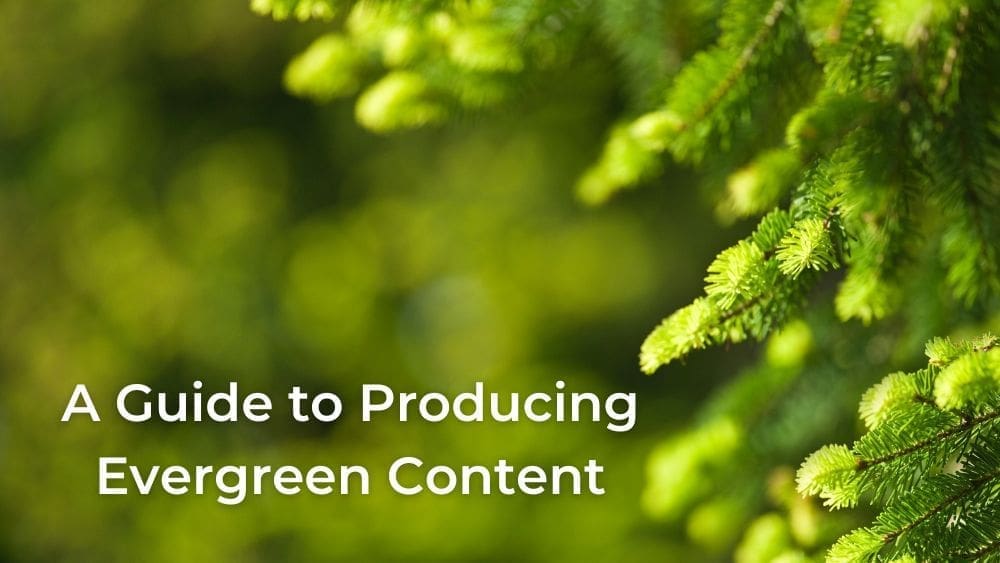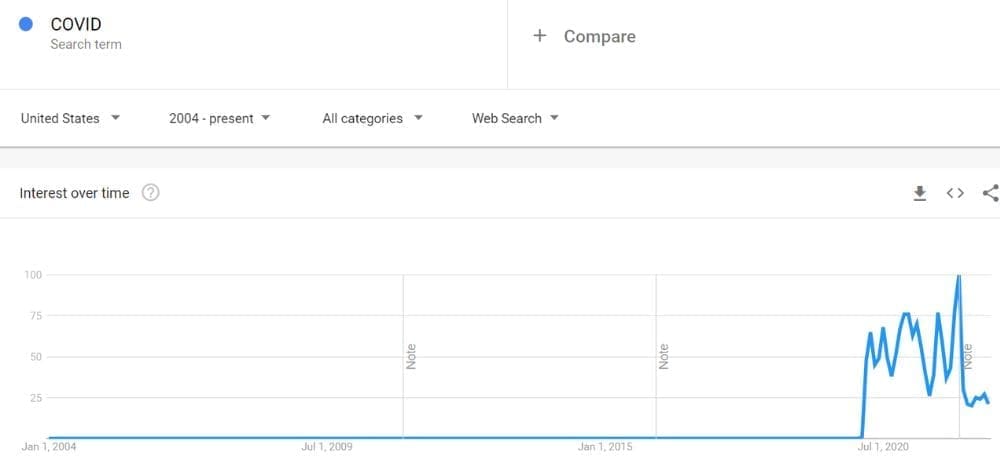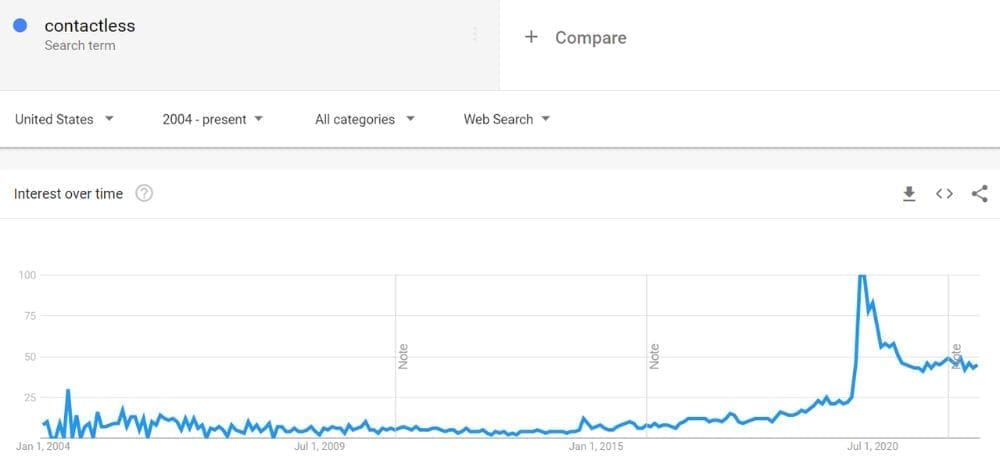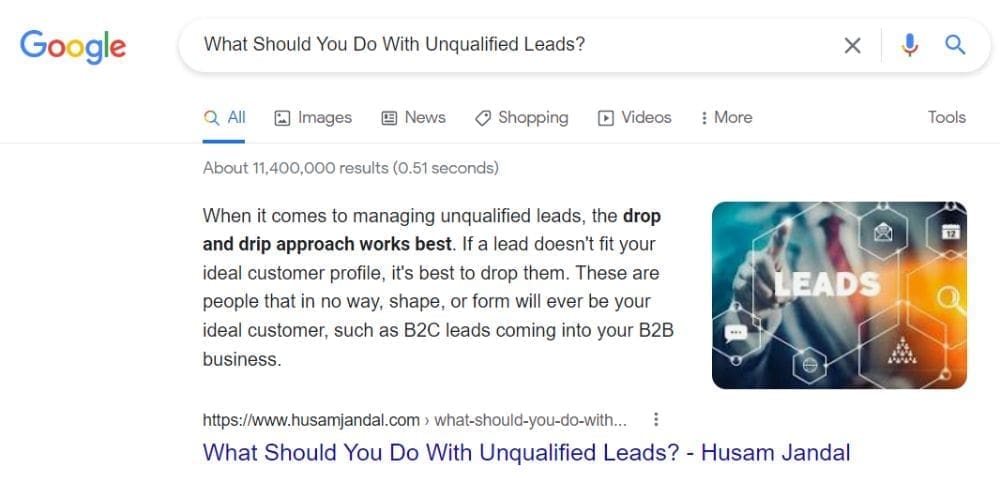
Evergreen content is a key component of strong digital marketing strategies because it helps you increase organic traffic exponentially while maximizing your return on investment. However, it’s widely misunderstood. On this page, I’ll walk you through some examples of evergreen content and what it can do for your business. You’ll also learn how to spot non-evergreen content and get some tips to help you start creating your own evergreen content right away.
What Is Evergreen Content?
Evergreen content is content that doesn’t expire. It’s as useful to readers five years after it was published as it was on day one.
I’ll use Google Trends to help you visualize the information as we go. It’s a free tool anyone can use that provides historical data about the level of interest in various topics. Take “digital marketing,” for example.

As you can see in this Google Trends chart, interest in digital marketing sparked around 2010. Since then, it’s largely held steady or grown. That means it’s evergreen.
What Evergreen Content Isn’t
It can be difficult to split out true evergreen content from the rest because some content types masquerade as evergreen content and may be mistakenly referred to it by various sources.
Seasonal
While there are benefits to writing about things that generate interest at the same time every year (tax-related, holidays, back-to-school, etc.), these aren’t truly evergreen. You can see this in the example below with “Halloween décor.” It peaks in October every year and then drops back down. Although well-written content like this can give you an ongoing boost yearly, the drop when the season ends means it’s not generating continuous interest. Therefore, it’s not really evergreen.

News and Trending
Coverage of news and trending topics (COVID, elections, celebrity gossip, etc.) can help you get thought leadership points or an immediate boost in traffic, but these pieces come with an expiration date. In this example, we’re looking at “COVID.” You can see the sharp decline in interest. It’s not a good evergreen topic.

Topics of Declining Interest
Sometimes topics have sustained interest over a long period, but they’re now on the way out. Facebook is an example of this. Even though it’s still a strong search term, you can easily see how much interest is declining. That doesn’t mean you shouldn’t write about Facebook, only that you’re not going to get the same mileage from a post about it as you might from a general post about social media or a post about another social network.

The Importance of Evergreen Content for SEO
We may never know all the signals Google’s proprietary algorithm looks for. Still, we do know that it and other search engines are always trying to give readers the best possible experience and quick access to information. Because of this, evergreen content can significantly impact search engine optimization (SEO).
Your Content Gets More Attention
Let’s say you wrote a blog about your company’s response to COVID. People would have been searching for that topic and linking to your blog at the height of the pandemic, but then traffic would have immediately dropped as interest in the topic waned.
Now, let’s say that you wrote about contactless solutions instead of producing this piece that relates explicitly to COVID.

You can see that, although there was a decline, interest in contactless solutions has largely held steady since the immediate drop. That’s probably because, although COVID brought awareness to the need for contactless solutions, people realized going contactless had benefits beyond protection from COVID.
That means a post about contactless solutions would fare better in the long run than a post about COVID. It’s evergreen.
Interest in evergreen topics doesn’t wane, so you’ll continue getting links and shares long after the content is written.
Your EAT Score Increases
EAT is short for expertise, authoritativeness, and trustworthiness. It’s widely accepted that every website has an EAT score that impacts where it lands in search rankings. The more you’re viewed as an expert, the higher your site ranks. You build your EAT score by consistently publishing high-quality content related to your specialty and having people consume it.
Your Organic Traffic Increases
As links to your evergreen content build up over time and shares increase, Google learns that your site delivers on user expectations. It provides a good experience. As you develop more content related to your area of expertise, Google learns that you are the authority in your area of specialty too. It then presents your content higher and more often in search results. Most people don’t read past the third search result, let alone click through multiple pages, so you get significantly more organic traffic because you’ve shared evergreen content.
Evergreen Content SEO Example
A while back, I published a post called “What Should You Do with Unqualified Leads?” It’s a topic that I know many small and midsized businesses struggle with, plus it falls within my area of expertise. It’s also evergreen. Businesses have had questions about lead management for as long as they’ve had leads. Plus, the wisdom shared in the article is as helpful today as it was when it came out.
So, what happens when people search for that term today?

As you can see, I don’t just land first in the search. I take the coveted Featured Snippet box. This means that Google’s algorithm determined my response wasn’t just the best answer to the query. It was the answer. It is the only answer Google thinks searchers will likely want to see. You can get similar results with your evergreen content too.
Tips for Writing Evergreen Content
If you want to increase your organic traffic by including evergreen content in your digital marketing strategy, these tips will help you get started.

Do Your Research
There are many ways to perform your initial research.
- Social Media Marketing: Evaluate your top posts on social media and make note of the top performers. Then, remove anything that didn’t sustain interest over a period of time.
- Site and Search Data: Use your own analytics to identify which pages and posts on your site are the most popular. Then, take a look through historical data to eliminate content that didn’t maintain momentum.
- Experience: Do your customers often approach you with the same questions time and time again? It may signify that there isn’t a good resource that answers their questions. Search around online to see if you can fulfill this unmet need.
- Keyword Tools: Use your preferred keyword tools to identify which keywords and questions have a high search volume. Again, you’ll look at historical data to remove words and phrases that saw a steep drop in traffic.
- Google Trends: You can use the tool as I did earlier to filter out non-evergreen terms. You can also use it to identify emerging trends. While most of these may not have staying power and be truly evergreen, you, as the expert in your industry, should have a good idea about what’s here to stay.
Choose the Right Topics
Once you’ve developed a list of potential topics and keywords, consider which topics are most closely related to your area of specialty. Specialized tools can help you break the list down even more, but you can also run searches for anything you’re considering writing.
If you find that the topics you want to write about are currently dominated by strong content or competitors, it may be better to choose less competitive topics or find a unique spin on them.
Avoid Specific Events and Dates
I often see lists that say something akin to “Most Important Social Media Stats of 2008,” and these get lumped in as evergreen content. If you’re putting a date in it, it’s not evergreen. You, as a reader, already know you don’t want to read stats from 2008! You want today’s stats.
Similarly, you should avoid including dates in your body content too. For example, you don’t want to say, “This trend grew 200 percent between 2008 and 2009,” to highlight recent growth. The second your readers sniff out that you’re using old data, they’ll bounce from the page.
This also goes for current and upcoming events. If mentioning something will cause parts of your content to seem outdated or obsolete later, it’s best to rephrase it or eliminate it entirely.
Stick to Proven Formats
Although evergreen content can be produced in countless formats, you’ll shorten the learning curve if you stick to creating:
- Guides
- Tips
- Listicles
- How-Tos
- Reviews
- Analysis
- Case Studies
Maintaining Your Evergreen Content
Even evergreen content needs TLC from time to time to keep it performing at its best.
Update Your Content Regularly
Updating your content provides two huge benefits. First, your content management system will usually stamp it with a new publish date, which Google views positively because it means you’re maintaining it. That means your content can rank better. Secondly, even evergreen content ages. You may want to update stats, incorporate new keywords, add more images, or rephrase things. Reviewing your content annually and making slight tweaks to pieces, or even totally refreshing them, can improve the user experience.
Continue Promoting Your Content
Keep promoting your evergreen pieces as part of your overall content strategy. Change the angle each time you reshare something and add new hashtags to help it reach new audiences.
For example, let’s say you run a travel company and produced a piece on the top island vacation destinations. Your initial social media marketing can promote it as-is. Then, around Valentine’s Day, you can discuss how romantic island vacations are and share the piece again. When the colder months hit, you can rerun it with mentions about escaping winter. The options are endless for well-written evergreen content. By including these types of pieces in your overall content strategy, you’ll always have something fresh and exciting to share, even if you aren’t producing new content all the time.
Repurpose It
You invested time in creating your content, so make sure it gets the most mileage possible by repurposing it. For example, turn some portions into an infographic or share individual stats you gathered for it. Also, consider remaking the piece as a video or sharing it as an email.
Get Linking
Links from one piece of evergreen content to another make your work more discoverable. They also tell Google and other search engines that the content being linked to is important, so it often ranks higher.
Get Help Improving Your Content Strategy or Overall Digital Marketing
When you take a mindful approach with your content strategy and ensure that each piece you create genuinely helps drive traffic in the long run, your investment decreases, and your return increases. It makes your digital marketing more effective overall too. But, creating evergreen content is only one aspect of a multifaceted strategy. If you want help shoring yours up or aren’t getting the results you want from your digital marketing, I’m happy to chat. As a seasoned digital marketing consultant with experience educating Google Partners and helping Fortune 100 companies scale, I now focus exclusively on small and midsize business growth and welcome the opportunity to discuss your needs and challenges with you. Please contact me for a complimentary consultation.




































































